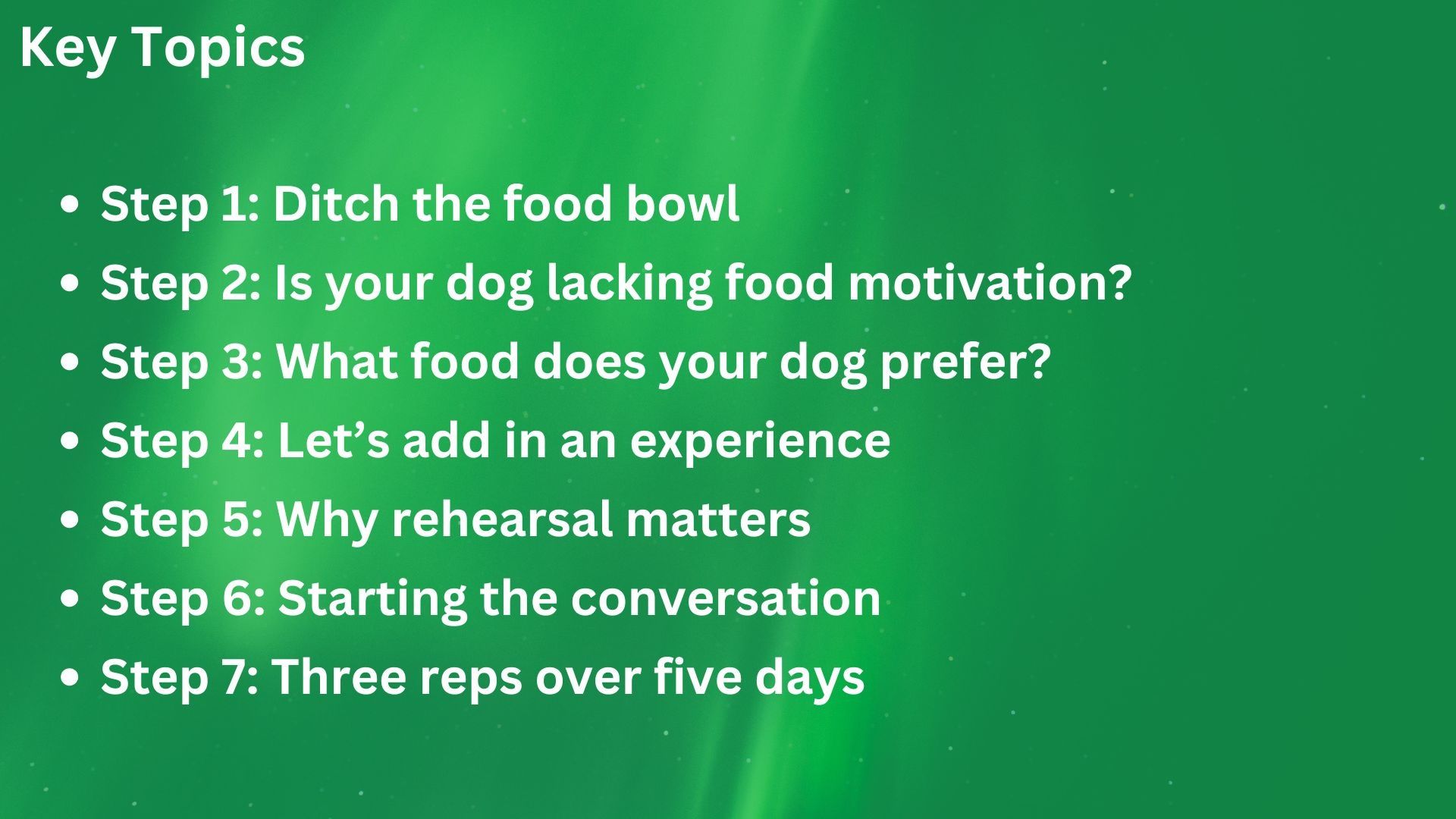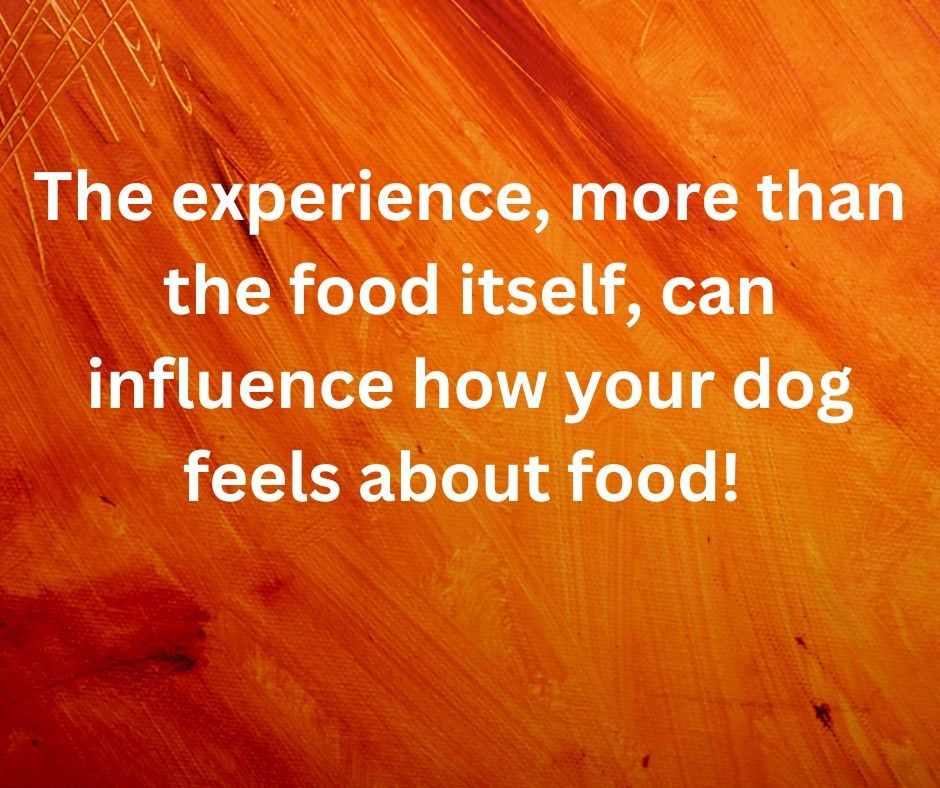7 Steps to Growing a Food Motivated Dog

Key Topics
- Step 1: Ditch the food bowl
- Step 2: Is your dog lacking food motivation?
- Step 3: What food does your dog prefer?
- Step 4: Let’s add in an experience
- Step 5: Why rehearsal matters
- Step 6: Starting the conversation
- Step 7: Three reps over five days
Food motivation for any dog can range from those who take food anytime, anywhere to those who turn their nose up at food starting with mealtime.
If you have a dog who lacks enthusiasm around food, it can be much harder to get excited about training because using other reinforcement options lack the ease of delivery that using food provides.
So, if you have one of those dogs, what can you do?
First know that all is not lost! If you follow the steps below, you can increase your dog’s willingness to work for food.
Work through these steps in order and always go at your dog’s pace. You may need to stay three weeks on the first step but 2 days on the 4th step. It’s all okay. Let your dog’s behavior dictate how fast you move forward.
Growing Food Motivation in 7 Easy Steps
Step 1: Ditch the food bowl
Start your journey by ditching your dog’s food bowl. What does that mean? Watch the video by Absolute Dogs “Ditching the Bowl – Taking Your First Steps“ and download the free ebook to learn how you can take that bowl of daily food and use it to grow your dog’s food motivation.
Giving your dog an opportunity to work for their daily food allowance will make mealtimes more interesting. You can also use a portion of their meals for training, growing calmness, and providing mental enrichment.
Step 2: Is your dog lacking food motivation?
Some dogs may not look food motivated even though they are. How do you know if your dog falls into this category. Ask yourself:
- Is my dog overweight?
- Is my dog just full, or feeling nauseated and doesn’t feel like taking in more food?
If your dog is overweight, time to reduce their food quantity. Start weighing your dog’s daily food allowance and reduce how much you are feeding by 10%. You can find other ideas for weight loss at Dog Aware “Weight Loss Diets for Dogs”.
If you have just fed them, perhaps they are full and not interested in more food. If they usually take food and have stopped, perhaps they have eaten something that isn’t sitting right with their stomach.
Step 3: What food does your dog prefer?
Knowing what your dog likes is the next step on your journey. Just like us, dogs enjoy different types of food. As you start to figure out what type of food your dog prefers, think about both the texture and the flavour.
Texture- Do they like soft foods like boiled chicken or turkey? Or do they prefer hard, crunchy foods like kibble and biscuits?
Flavour- Are they a chicken lover? How about pork, beef, hot dogs, or garlic sausage?
Which food lights your dog up when you offer it to them? Experiment with different types of food. Purchased treats can get expensive so don’t hesitate to purchase inexpensive meat, cook it up and see how your dog responds.
If you would like a variety of easy to make treat ideas, sign up to receive my free, monthly newsletter and receive a copy of my “Great Treat Ideas” ebook for ideas to get you started.
Step 4: Let’s add in an experience
Eating isn’t always about taste. What makes the entire food experience enjoyable is often the experience that comes with it. The experience, more than the food itself, can influence how your dog feels about food!

How you deliver food to your dog can increase the motivation they have around food.
Most of the time, food is given to your dog by feeding it directly into their mouth. Not very exciting.
What might happen if you start tossing it across the floor for them to chase or tossing it into the air for them to catch? Your dog is now more engaged with the process and they bring a totally different energy to the experience!
What does your dog like? Is your dog passionate about movement, do they spend long moments sniffing the ground, do they like to hunt for something?
Animating their food to trigger their chase instinct or their sniffing passion! Roll the food, toss it for them to catch, bounce it! Scatter some food in the grass.
If your dog knows some behaviours, ask them for a few and reinforce their good choices by animating the food.
Animation makes food delivery about more than just the food. It becomes about the whole experience around the food!
Step 5: Why rehearsal matters
Dogs get better at what they practice every day.
If your dog has a history of refusing food, especially when you are out and about, they will be more likely to continue to say “NO” to food in the future. If you can change the picture so that your dog starts to say “YES” to food, they will say “YES” more often.
The more they respond to your efforts with a “YES”, the closer you will be to a dog who engages with you and is motivated to work for the food you are offering!
Step 6: Starting the conversation
You want to prepare your dog for a food related conversation by using simple behaviours to communicate that a food experience is coming. For example, you could say your dog’s name and when they look at you, toss a piece of food for your dog to catch, or roll a piece of food for them to chase.
You can also use any simple trick that you have taught your dog like spin or one of my favourites, Two Paws On.
Whichever option you use to start the conversion, begin by playing the game in the house, play it in the backyard and then, take it on the road. Play it in your driveway, in front of your house, around the block and gradually start to take it to more distracting environments.
If you play Two Paws On, you can use a lightweight, portable object to take with you when working in the environments listed above. The advantage of having on object with you is that it provides a clear, visual cue to your dog that you are going to play a food related game.
Step 7: Three reps over five days
Now that you have built a foundation and are growing more “YESes”, you can level up your dog’s learning with this easy game called 3 Reps.
Using your dog’s daily food allowance, you are going to create some anticipation around food. Plan to use approximately 60% of their food allowance throughout the day playing the 3 Rep game.
Here’s what to do:
- Take three pieces of food. Flick one for your dog to eat, roll another, and toss the last one. Say “all done” and go back to doing whatever you were doing.
- Repeat the above later in the day.
- Continue repeating these short, fast, fun sessions throughout the day until you have used up the allotted food allowance.
- Mix up the experience by incorporating games into the sessions. Say their name, when they look to you, play catch. Play Two Paws On and release them to chase a piece of food, play the Orientation Game. Still keeping each session to three repetitions only.
- Play the 3 Reps game over 5 days (or more) until your dog readily takes food in a variety of different environments.
You could also add in a surprise treat of something they really like just to keep them guessing and motivated, so they never know what is coming next. Soon you will start to notice your dog engaging with a little more enthusiasm!
Where should you play 3 Reps?
This plan is a starting point. Your dog may need more time in the easy environment before moving to a weird location or a more difficult location. Always go at your dog’s pace. You are looking to see an increase in motivation and enthusiasm in each type of environment before moving onto the next type of environment.
- Day 1-2: Easy environments. Playing inside your house in a low distraction environment. Choose places where they have said “YES” to food before. The context will make it easier for them to continue to say “YES” to food as they engage with you in this new way.
- Day 3-4: Weird locations. Play in places where you wouldn’t normally interact with your dog (a bedroom, doorstep, storage room). These spaces aren’t more difficult or distracting, just atypical in terms of location and context.
- To build more context, from Day 3 onward use your conversation starter (Step 6) before each session to help your dog understand what’s going to happen.
- Day 5: A more difficult location. Try something a touch harder than Days 3 and 4 but still familiar. Playing the 3 Reps game throughout your walk would be a good next step.
Conclusion
You are now creating an experience around food. As your dog starts to work for the food you are offering (chasing it, sniffing for it, licking it) the food’s value is increasing along with their desire for it!
Observe your dog and celebrate any change in motivation that indicates your dog is becoming more willing to work for food! Above all, have fun because that’s what owning a dog is all about.
References:
“Help! My Dog” podcast Episode #8
STAS: Creating Food Drive in Your Dog
STAS: My Dog Just isn’t Food Motivated
Additional Resources:
To learn from Dr. Mitchell, check out:
Check out our Upcoming Classes webpage for dates and times of our current class offering.
Stay in Touch
GET THE FREE EBOOK
Discover 12 easy treat recipes that your dog will love and that won't cost a lot of money.
AREAS WE SERVE
Proud of My Dog is located along the shores of Slocan Lake in beautiful New Denver, BC
In-person we serve, the North Slocan Valley, Nakusp, Kaslo, and the Village of Slocan.
On-Line we serve: The world!
Currently all of our in-person group classes are held in New Denver and Nakusp.
Proud of My Dog
Copyright Proud of My Dog 2020



